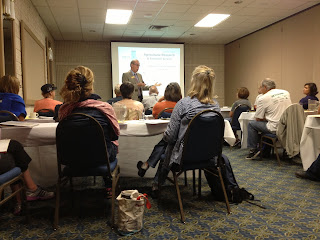The 8th July was my last day in Idaho before setting my sights further East. Robert and I headed around the farm one more time to take in the scenery before heading North to the University of Idaho. This is where Robert dis some of his agricultural training, so we called in to see the building and have look around. Agriculture still plays a major role, not only for the University but also for the farming community with links passing genotypes around between them and Limagrain who I met last week. The fund raising staff, headed up by Kim O'Neill had just finished raising $40 million for the University Agricultural and Life Science Dept, over the past 5 years, almost 2 years ahead of their target. Very impressive!
While we were there some teacher training was being taken by the now principal John Foltz. We gate crashed the party which is under a scheme called 'Ag In The Classroom'. It is a great idea and I had hairs on the back of neck standing up listening to the ideas. Basically the teachers; during the summer recess come to learn about Agricultural production, food and the environment as part of their Continued Personal Development (CPD). I think the course is about a week long, (I will find out more). It seems sensible to educate teachers who can then pass that knowledge down to their children and teachers are already respected and trusted by them, brilliant! There was even a combine in the hotel car park!
We rushed through the meeting and I gave a short presentation, spur of the moment, thanks Robert, on Nuffield and why this funny speaking (correctly) person was in the room. We headed north to Spokane afterwards where I met up wit h6 friends from the Contemporary Scholars Conference, back in March, on their Global Focus Program. Here we had a 2 hour presentation and discussion about the Farm Bill in general but focused on the Crop Insurance Program the farmers can use to guarantee there out put, financially or physically form the farm. there are basically 3 types. the cheapest is yield protection up to 85% of your expected, based on the last 5 years crop receipts from the local elevators. The second form is Revenue protection where you can insure for yield and the price at harvest. Thirdly there is Revenue protection excluding harvest price which takes into account increases in the grain price. It was fascinating to hear how the system works, but I didn't realise that 80% of the farm bill goes on food stamps for people on state benefits. Of the 20% left there is some for Conservation and some for administration so the actual support to the farmer is only about 11% of the total cost.
Here is Matthew, me, Natasha, Guy, Jodie, Kara and Sophie after the meeting. It really was great to catch up even for such a short period of time, it was like meeting old friends again. Great!
Idaho has been stunning, my host, Eisenhower Fellow Robert Blair and family have been tremendous and he has shown me everything about their wheat and general crop production methods. (Nuffield Scholars need to make more of this Agricultural resource). I leave you with two picture form the area, taken on the last day. This one shows two fields, one is cultivated with minimum tillage and the other is with mould board ploughing. There is quite a difference.
The second one is this, of a White Tailed Deer. They are there in abundance, along with the Elk, and it demonstrates that farmers are capable of farming in harmony with nature, but we have to let our critics and customers know this is how we do it!






2 comments:
Could you give a bit more on the differences between the two adjacent fields that you observed (Min till vs ploughed?) Which was which? And were they typical this season?
The greener one on the left is min tilled as it retained more moisture and therefore kept the crop alive for longer which in turn will increase the yield.
Post a Comment